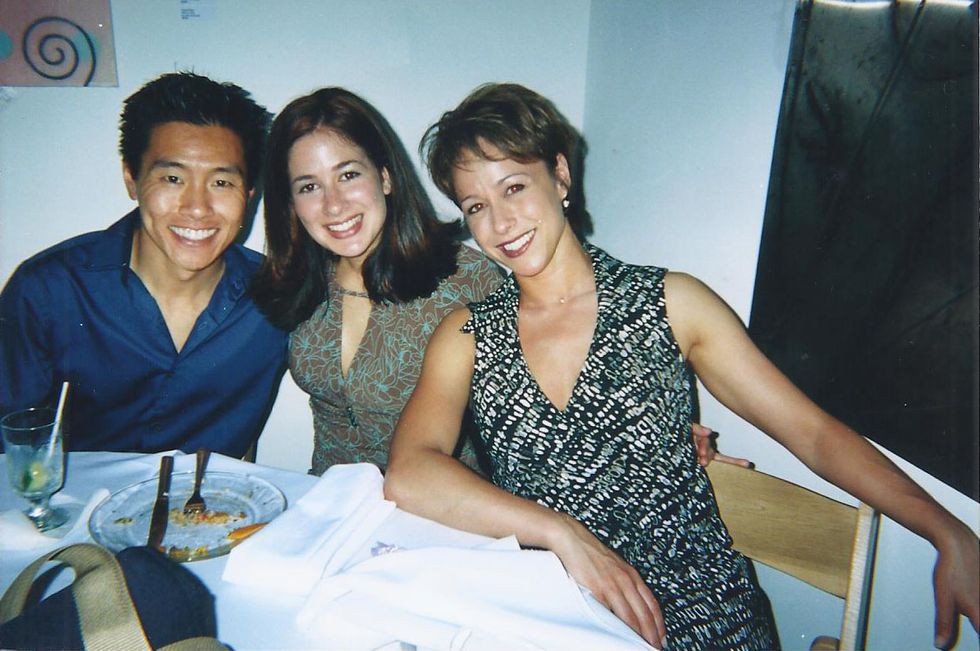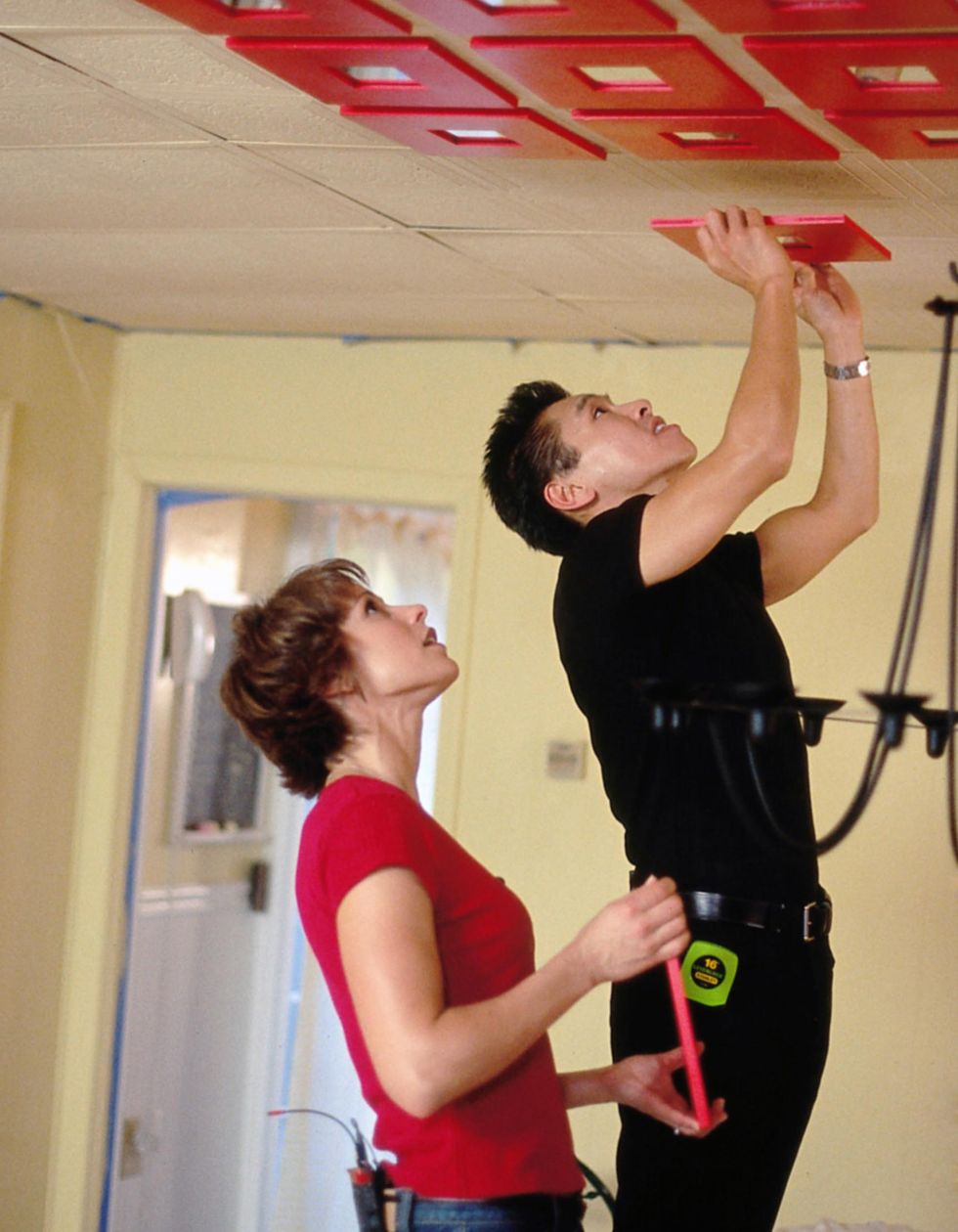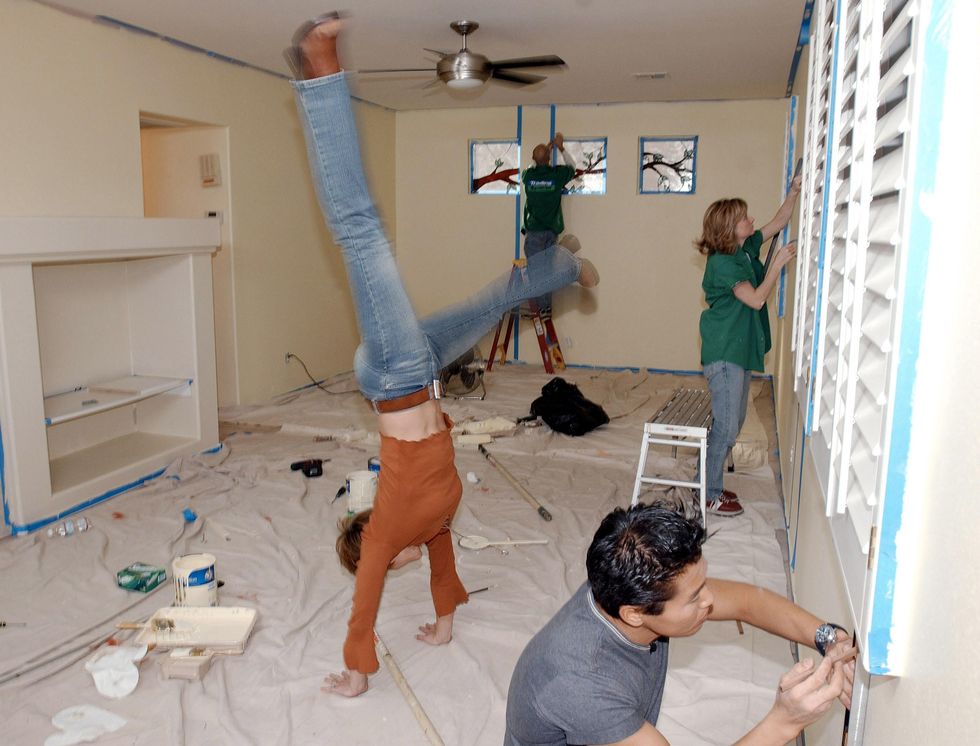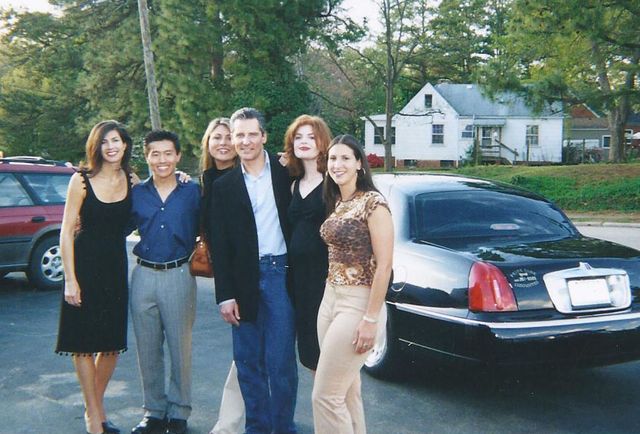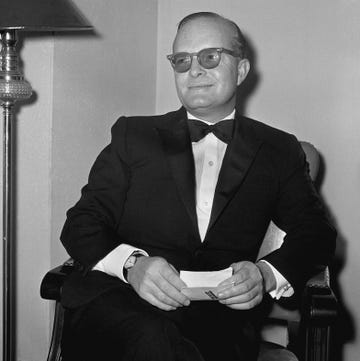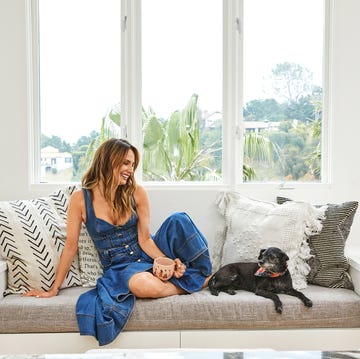Two sets of neighbors, two designers, two days and a $1,000 budget. We bet you're already starting to sweat thinking about what could possibly happen. It's that same anticipation that fueled our love of Trading Spaces and lead the show to ratings gold shortly after its premier on October 13, 2000.
"We were getting six million people watching every show," designer Vern Yip recalls. "In this day and age, most shows are lucky to get one million."
You'll remember Yip as the creative perfectionist with a background in architecture, who always had a detailed plan of attack. He was also a huge fan favorite because that preparedness meant he always delivered stunning rooms that felt within reach of the average viewer and, to be honest, looked great despite the time and budget challenges (we all remember some of the other crazier rooms).
By the time Yip said goodbye to the TLC show after four seasons, he had toured the entire country with the cast and crew, appeared on a sky-high billboard in Times Square and even attended the Emmy Awards (the show was nominated twice). Nearly 10 years after the series finale in 2008, Yip is still a tremendously successful designer. He has appeared in multiple HGTV shows, published a design book last fall and still takes on decorating projects — yes, you can hire him to make over your own room, no neighbors required.
Despite all the drama and chaos America enjoyed seeing each week on the show, Yip remembers his time on Trading Spaces fondly, and sat down with us to share what it was really like behind the scenes. These tidbits are almost more surprising than the reveals we watched on TV.
1. Yip originally turned the show down.
He had just won the award for Southeast Designer of the Year, had a lot of high-end clients and, honestly, didn't know if he — or anyone — could pull it off. Think about: two days, $1000, amateur helpers. It's nuts. But the network pursued him hard — partly, Yip admits, because he fit a mold they needed. "Each designer had something different to offer," he says. "There was the graphic designer, the artist and I was supposed to be the formally trained architect."
Apparently, they wore him down. "I finally decided to do it, because I really loved that it was the first show to say great design shouldn't just be relegated to the top of the socio-economic ladder — it should be available at all price points." Remember, these were the days before retailers like Target had designer collaborations at more affordable prices, and HomeGoods hadn't made it big up yet. Interior decorators were often the only people shopping at design centers.
As soon as Yip began his first episode, he knew he'd made the right choice. "I remember feeling such exhilaration on that first shoot because it challenged me to really think outside of the box," he says. In these pre-Pinterest days, he himself had to get crafty in order to get things done. You might remember the kitchen he made over, which was for a couple of wine connoisseurs who loved to entertain. "I created a light fixture over their kitchen table, using wine glasses and a cord." And so it all began.
2. Some designers didn't care what the homeowners wanted.
Here's how pre-planning worked: About six weeks before filming each episode, designers would receive a packet from the production company with their homeowner assignment. It included things like a questionnaire filled out by the neighbors detailing things like design deal-breakers and favorite colors, as well as a VHS tape (yes, really) tour of the space. Helpful, right?
Well, Yip wouldn't name names (but we can definitely guess!), but a few designers chose to never open their packets. "They felt the video tape and questionnaire were too constricting and thought if these people wanted to hire designers, then they should do that," he says. "But since they signed up for this show, these designers weren't going to be creatively constrained."
As for Yip, he dissected the packet and poured over the information (and that's probably why he never had one bad reveal). "People didn't really know how much of a Russian Roulette it was being on the show," he says.
3. Designers had to pay when they went over budget.
Yes, really. But soon into the show, the producers decided the flexibility of being able to use your own money for extras didn't cut it and changed the agreement. "Eventually they started making you take items out of the room instead," he says. To avoid this, Yip would create a spreadsheet for every room outlining his purchases. Then someone on the crew would go through the spreadsheet with his receipts and make sure everything was accurate.
To get the best deals, buying for the show was a year-round experience. "I spent a lot of time at the Pottery Barn, Restoration Hardware and Crate and Barrel outlets," he says. He even had an entire room in his house where he put all of these purchases. "I would end up buying anything I thought had good bones and would keep it in the room with a receipt taped to it," he says. What we would've done to be a fly on that wall.
4. That's why Yip took full advantage of free hotel supplies.
Desperate times calls from desperate measures — and Yip was willing to do whatever it took. "They would put us up in hotels where you got a free breakfast in the morning," Yip recalls. "And since everything had to come out of your budget, I would steal apples and flowers from the breakfast bar."
It was these creative loop holes that flexed Yip's skills the most. "It taught me discipline and what to spend money on and what not to spend money on," he says. And since Yip refused to sacrifice on quality, it was an even greater challenge for him to work on a tight budget. But in the end, he says, his work proves you can achieve great design on any budget.
"I also did a lot of my own carpentry," Yip reveals. Though the carpenters on the show did help him, they didn't have enough time to do everything Yip needed. This DIY experience has giving him a leg up in the industry he didn't expect, he says. "I now know what's feasible and what's not when a contractor tells me a timeline."
5. But he never actually slept in his hotel room while shooting.
Well, with the exception of one night. Here's a shocker for you: That whole leaving-the-homeowners-homework conceit at the end of day one was a bit of a set-up. Sure, it might have worked for some of designers, but Yip was so dedicated that he pulled all-nighters on all but one episode. "It was always so funny when on day two, I had to ask the homeowners how they did on their homework, because, of course, it was me who did it," he says. Though Yip acknowledges it was his choice to plan such ambitious projects.
"I was the one saying we're going to put down a new floor or tile this fireplace and it simply wasn't fair to expect homeowners to tackle that," he says. He also points out the homeowners weren't used to being filmed on camera and the way it zaps your energy.
"I remember getting back to the hotel, showering, changing and going right back to set, when I felt like I was going to die, because I was so bone tired," he says.
6. Renovations were filled with surprises.
His toughest moment from the show happened in an old historic home, where the kitchen had never been renovated. Yip says past homeowners had just layered seven different flooring materials on top of each other, but underneath was beautiful wood. In order to get to the wood, Yip had to tear out all of those layers of vinyl and linoleum by hand.
"I remember at one point I found a piece of old chicken between two layers and I remember thinking to myself that I had hit my limit," he says. While he knew it wasn't the homeowner's fault, that didn't make removing it from the floorboards any less, well, disgusting. "At the end of the day, I just had to pull through and do these people right."
But Yip says there was nothing like the high of a reveal for him (after all, he had a 100% success rate). A bedroom makeover in Maryland stands out as one of his favorite makeovers. It was early on the show, so he was still figuring out the process and had an "aha" moment with icicle ornaments that he hung from the canopy of the bed to create a serene vibe.
7. The behind-the-scenes moments were even more dramatic.
We all witnessed the worst reveals on camera. But keep in mind that after filming stopped, homeowners got even more real. "I remember one time the people were so upset by what they saw that production had to hide the designer in the coat closet in the foyer and sneak her out of the house," Yip says.
Then, there was the fame effect. Season one premiered as a daytime show, but by season two, the show was airing during primetime. "People were having viewing parties in college and staying in on Friday nights," he recalls. Of course, this kind of success impacted filming, too: "We'd roll into a new town, and there'd be a parade of people lining the street."
For this reason, Yip says some of the most rewarding days of his career happened when he was on the show. "I got to travel and see how diverse our country really is, and how we have more in common than what makes us different," he says. "It restored my faith in humanity and was an amazing experience. Exhausting, but special."
8. Yip said he's totally down for a "Trading Spaces" reunion.
Even though he points out things are different now ("I wouldn't be able to do the same pace in a weekend and I have kids now"), Yip says he would be 100% down to take on the challenge again. "I think it would be so much fun because the game has changed so much."
Since Yip still keeps in touch with a few designers (like Laurie Smith!), we'll leave it up to him to broach the topic at their next reunion. Come on, give the people what they want!

